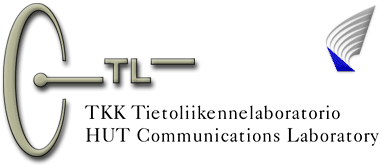
Suomeksi
Case 1
Case 2
Case 3
Problem
Study questions
Protocol example
Contents
Whereas previous courses have discussed transmission
paths, modulation and networks, this course is about how to use existing networks, particularly
the Internet. We'll cover the rudiments of communications protocols and
see how they can be used to realise reliable data transport service on
top of the potentially unreliable network and how to use this service
to develop various applications seen by the end user. The
approach is software-oriented. The course is divided to three major
parts
- reliable connection-oriented data transmission
- virtual local area networks
- the client-server approach and
application services
Prerequisites
Because of the
software-oriented
approach of the course, it is very important to master the basics
of
computer programming. Communications protocols are computer
programs and
the course material is much easier to understand if you have aquired at
least
some practical experience in programming, e.g. by doing the exercises
of some
basic course. "S-38.1105 Tietoliikennetekniikan
perusteet" (Fundamentals of Telecommunications) and "S-88.1110
Digitaalitekniikan perusteet" (Fundamentals of Digital Circuits and
Devices) are also useful as
prerequisites.
How to study
The first lecture is on Wednesday,
April 2nd at noon in room S4. After that, we'll have some
lectures but the main emphasis is on Problem
Based Learning (PBL), a student-centered approach to teaching
that revolves around small study
groups.
In PBL, a real-life-like problem is presented to a group
of students. The group tries to solve the problem through discussions
and individual work. The teachers step back and act as coaches,
advising only when needed.
The group sessions take place once a week in the network
cafe. Between the sessions it is expected that you devote one
working
day (or two half days) to individual study. The English-speaking
study group meets on Tuesdays, 12 noon to 2 p.m. starting April 8th.
You can register to the group .
If you register, remember that there
is a (moral) obligation to actually attend group sessions and also to
do some work between sessions. You'll receive some credit by
attending sessions but it is not mandatory.
There are several good books on this field, but they tend to be much thicker than is required for this short course. Besides, just trying to memorize a book or part of it is not a particularly good idea – you’ll soon forget most of it anyway. Instead, whether you are attending a group or not, try to solve the problems given in the margin, using the books, web sources etc. as reference material. The problems resemble those that you might encounter in real life and in each of them you are expected to explore some new territory. As in all complex design problems (say, planning a house) there are good and bad solutions but no single “right answer”.
At the end of the list you’ll find a list of review questions. If you find it exceedingly difficult to “ask the right questions” while working at the problems, you might go straight to the review questions but don’t expect them to be a breeze, either.